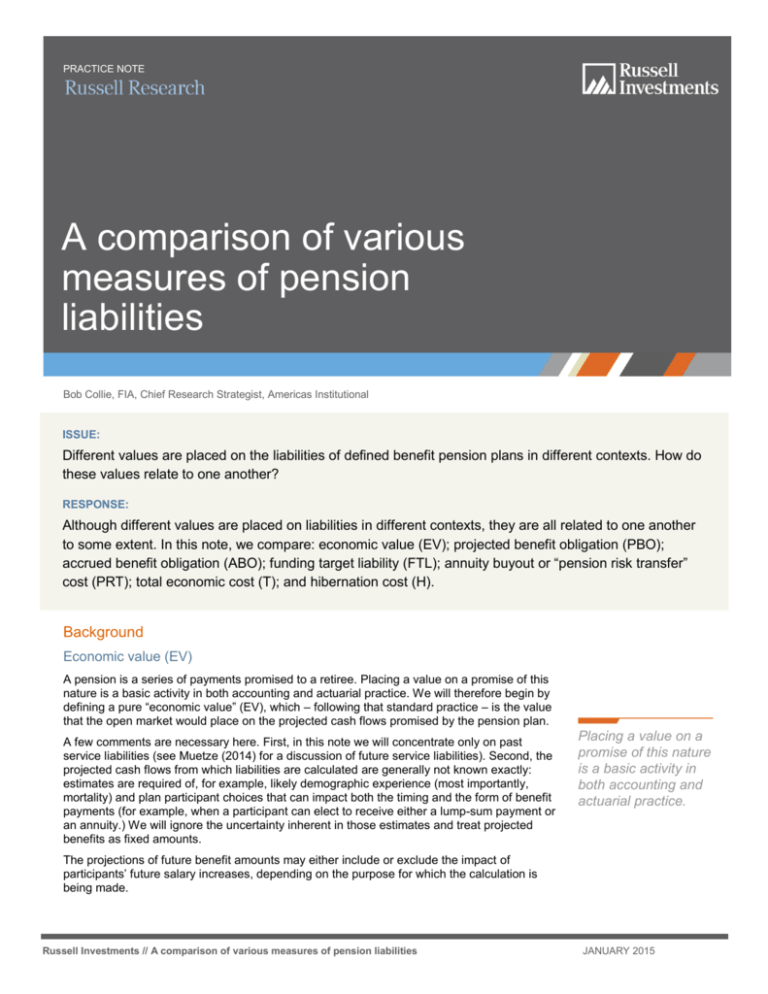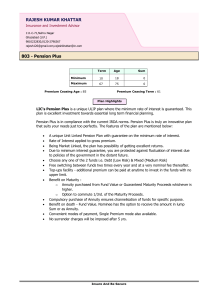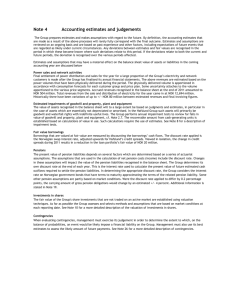
PRACTICE NOTE
A comparison of various
measures of pension
liabilities
Bob Collie, FIA, Chief Research Strategist, Americas Institutional
ISSUE:
Different values are placed on the liabilities of defined benefit pension plans in different contexts. How do
these values relate to one another?
RESPONSE:
Although different values are placed on liabilities in different contexts, they are all related to one another
to some extent. In this note, we compare: economic value (EV); projected benefit obligation (PBO);
accrued benefit obligation (ABO); funding target liability (FTL); annuity buyout or “pension risk transfer”
cost (PRT); total economic cost (T); and hibernation cost (H).
Background
Economic value (EV)
A pension is a series of payments promised to a retiree. Placing a value on a promise of this
nature is a basic activity in both accounting and actuarial practice. We will therefore begin by
defining a pure “economic value” (EV), which – following that standard practice – is the value
that the open market would place on the projected cash flows promised by the pension plan.
A few comments are necessary here. First, in this note we will concentrate only on past
service liabilities (see Muetze (2014) for a discussion of future service liabilities). Second, the
projected cash flows from which liabilities are calculated are generally not known exactly:
estimates are required of, for example, likely demographic experience (most importantly,
mortality) and plan participant choices that can impact both the timing and the form of benefit
payments (for example, when a participant can elect to receive either a lump-sum payment or
an annuity.) We will ignore the uncertainty inherent in those estimates and treat projected
benefits as fixed amounts.
Placing a value on a
promise of this nature
is a basic activity in
both accounting and
actuarial practice.
The projections of future benefit amounts may either include or exclude the impact of
participants’ future salary increases, depending on the purpose for which the calculation is
being made.
Russell Investments // A comparison of various measures of pension liabilities
JANUARY 2015
The most important input to the calculation of EV is the discount rate: what value to place, in
today’s money, on a future payment of $1. One possible approach would be to derive the
discount rate from the price of U.S. Treasury bonds, since these represent the most widely
used proxy for the market’s assessment of the risk-free interest rate. However, as a basis for
understanding the various liability measures considered in this note, it is better to start with a
discount rate based on the price of high-quality corporate bonds. This results in a higher
discount rate (and lower liability values) than the U.S. Treasury yield, albeit with the
introduction of some risk of default/downgrade. In a sense, this economic value based on
corporate bond yields can be thought of as the price at which the pension liabilities would
trade in the open market, if the exact same promises were packaged as a bond issued by an
investment-grade-rated corporation.
This value (EV) is our starting point, although none of the liability values that we will consider
is exactly equal to it.
Projected benefit obligation (PBO)
PBO has typically
been around 5% to
7% below what it
would be based on
the most up-to-date
mortality
assumptions.
Since the 2006 publication of Statement of Financial Accounting Standard (FAS) 158 (now
incorporated in FASB Accounting Standards Codification 715), the PBO shown in the balance
sheet of U.S. corporations has been conceptually close to the economic value (EV) as
described above. The main difference in calculations performed up to the date of this writing
has been in the mortality assumptions: until recently, most corporations have used mortality
tables that were published by the Society of Actuaries (SOA) almost 15 years ago. These
tables do not reflect the increase in life expectancy that has occurred since then. As a result,
PBO has typically been around 5% to 7% below what it would be based on the most up-todate mortality assumptions.
The SOA published updated tables in 2014, as described in Owens (2014). The signs are that
most corporations will adopt the new mortality tables in either their 2014 or 2015 financial
statements. This will cause an increase in PBO, bringing it close to EV.
Accrued benefit obligation (ABO)
ABO is similar to PBO, except that it does not include allowance for the effect of future salary
increases. In the case of a frozen pension plan, benefits are no longer tied to future final
salary so ABO equals PBO. ABO also equals PBO for other plan types that do not link
benefits to final salary, such as cash balance plans or flat dollar benefit plans.
Funding target liability (FTL)
Unlike the other measures described in this note, the link between FTL and economic value
(EV) is quite tenuous, mainly because FTL most commonly uses a discount rate that is not
linked to current bond prices, but rather to a 25-year average. This is the result of recently
enacted legislation – the Moving Ahead for Progress in the 21st Century Act of 2011 (MAP21) and the Highway and Transportation Funding Act of 2014 (HATFA) – that was intended to
reduce corporate pension contributions and hence increase federal tax revenue (see Barbash
(2014).)
As of the end of 2014, the use of a 25-year-average yield can reduce stated liabilities by as
much as 20% to 30%. In addition, the new mortality tables mentioned above have not yet
been mandated by the IRS for use in the FTL calculation; the earliest that this could happen
will be January, 2016. These two effects lead to lower contributions in the short term, which
(unless investment/interest rate experience is particularly favorable) will need to be made up
later. Because of the tenuous link to economic value, the use of the funding target liability for
purposes other than the calculation of minimum required contributions can be misleading.
Russell Investments // A comparison of various measures of pension liabilities
The link between FTL
and economic value
(EV) is quite tenuous,
mainly because FTL
most commonly uses
a discount rate that is
not linked to current
bond prices.
2
Annuity buyout cost (PRT)
Annuity buyout cost is the sum required by an insurance company for a full pension risk
transfer (PRT).1 This cost is determined by the insurance company and varies depending on
market conditions. However, it tends to be fairly closely linked to economic value, since risk
transfer involves the insurance company’s taking on responsibility for payment of the
promised benefits. Therefore, the quoted price will reflect the expected cost of making those
payments, with some margin for defaults or downgrades in the fixed income securities held
and for insurance company expenses and/or profit.
The insurance company’s margin of safety requirement tends to be higher when there is
uncertainty as to the timing of payments, options for how benefit are received, or reinvestment
risk. Thus, benefits payable to young plan participants or those with lump sum options tend to
involve a higher margin of PRT above EV than benefits for current retirees.
While the extent of the margin of safety built into annuity pricing will vary depending on
competition and other market considerations, it would in general be imprudent for an
insurance company to sell business without any margin above EV. PRT should therefore be
expected to be some 2% to 5% above EV when market competition is high (as at present),
and greater than that at other times.
Total economic cost (T)
Although the cost of transferring the pension liability to an insurance company will nearly
always exceed EV, so will the cost of retaining that liability. This is because the plan sponsor
faces the same risk of default or downgrade in investment securities as the insurance
company does. In addition, there are administrative costs involved in running the plan, as well
as premiums payable to the PBGC (which have increased materially in recent years.)
For this reason, marketing materials and illustrations of annuity prices tend to compare the
annuity buyout cost (PRT) to the total economic cost to the corporation (T) of retaining the
plan.
There will also be investment gains or losses to the extent that the actual investment strategy
differs from a 100% fixed income hedging strategy; these gains or losses would normally be
considered separate from T.
Although the cost of
transferring the
pension liability to an
insurance company
will nearly always
exceed EV, so will the
cost of retaining that
liability.
Hibernation cost (H)
Hibernation involves a plan sponsor’s retaining a frozen plan for a period, with an annuity
buyout following at a yet-to-be-determined date. Because of the optionality around timing,
precise calculation of the cost of hibernation (H) can be difficult. However, since the sponsor
has control over the timing of a buyout, H should always be less than the total economic cost
(T) of retaining the plan indefinitely. It will also generally be less than the cost of immediate
annuity buyout (PRT), since the optionality that is built into this strategy itself has a positive
value.
Hibernation will tend to compare favorably to immediate buyout where the plan membership is
younger and the proportion of non-retirees (those whose benefit payments have not yet
commenced) is higher. The optimal time to end the period of hibernation and move to a risk
transfer is, ultimately, a matter of judgment.
Hibernation is discussed in more detail in Gannon (2014).
1
Because pension risk transfer requires a clear definition of sums payable, this applies only to benefits that are not linked to future salary
increases. Accordingly, ABO would equal PBO for those liabilities.
Russell Investments // A comparison of various measures of pension liabilities
3
Summary
While it is common to talk about the value of pension liabilities, there are in fact several
variations of this measure. Some of these are more closely related than others. Whenever
pension liabilities are being considered, care should be taken to be clear as to which measure
is being used.
LIABILITY MEASURE
COMMENT
Economic value (EV)
Analogous to the open market price at which the liabilities would trade if they
were packaged as a bond issued by an investment-grade-rated corporation.
Projected benefit obligation
(PBO)
The headline figure used on the corporate balance sheet. May use a different
mortality assumption than EV.
Accrued benefit obligation
(ABO)
As PBO, except with no allowance for future salary increases.
Funding target liability (FTL)
Used in calculation of minimum required contribution. Tenuous link to EV, due
to heavy smoothing of interest rate.
Annuity buyout cost (PRT)
Cost of immediately transferring liabilities to an insurance company.
Total economic cost (T)
Total cost of keeping liabilities in the plan indefinitely. Includes administrative
costs, PBGC premiums and effect of bond defaults/downgrades.
Hibernation cost (H)
Total cost of keeping liabilities in the plan for a period and transferring them to
an insurance company when it is most cost-effective to do so.
RELATED READING
Barbash, J. (2014, October). “DB plan funding in a pension stabilization world” Russell Practice Note.
Gannon, J. (2013, December). “Do PBGC premiums incent plan sponsors to borrow to fund their pension plan?” Russell
Practice Note.
Gannon, J. (2014, March). “Hibernation versus termination: Evaluating the choice for a frozen pension plan” Russell
Practice Note.
Muetze, M. (2014, May). “Introducing TFBO: A tool to help you understand the long-term economics of your plan” Russell
Practice Note.
Owens, J. (2014, February). “How will the new RP-2014 mortality tables affect my DB plan strategy?” Russell Practice Note.
ABOUT RUSSELL INVESTMENTS
Russell Investments provides strategic advice, world-class implementation, state-of-the-art performance benchmarks and a
range of institutional-quality investment products, serving clients in more than 35 countries. Russell provides access to some
of the world’s best money managers. It helps investors put this access to work in defined benefit, defined contribution, public
retirement plans, endowments and foundations and in the life savings of individual investors.
FOR MORE INFORMATION:
Call Russell at 800-426-8506 or visit www.russell.com/institutional
Important information
Nothing contained in this material is intended to constitute legal, tax, securities, or investment advice, nor an opinion regarding the appropriateness
of any investment, nor a solicitation of any type. The general information contained in this publication should not be acted upon without obtaining
specific legal, tax, and investment advice from a licensed professional.
Russell Investments is a trade name and registered trademark of Frank Russell Company, a Washington USA corporation, which operates through
subsidiaries worldwide and is part of London Stock Exchange Group.
The Russell logo is a trademark and service mark of Russell Investments.
Copyright © Russell Investments 2015. All rights reserved. This material is proprietary and may not be reproduced, transferred, or distributed in any
form without prior written permission from Russell Investments. It is delivered on an "as is" basis without warranty.
First used: January 2015
USI-21170 01-18
Russell Investments // A comparison of various measures of pension liabilities
4








